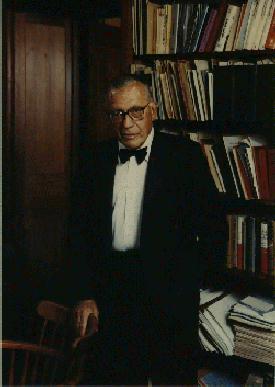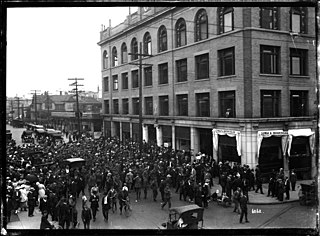Related Research Articles
A trade union or labor union, often simply referred to as a union, is an organisation of workers intent on "maintaining or improving the conditions of their employment", such as attaining better wages and benefits, improving working conditions, improving safety standards, establishing complaint procedures, developing rules governing status of employees and protecting and increasing the bargaining power of workers.
Labour laws are those that mediate the relationship between workers, employing entities, trade unions, and the government. Collective labour law relates to the tripartite relationship between employee, employer, and union.

The National Labor Relations Act of 1935, also known as the Wagner Act, is a foundational statute of United States labor law that guarantees the right of private sector employees to organize into trade unions, engage in collective bargaining, and take collective action such as strikes. Central to the act was a ban on company unions. The act was written by Senator Robert F. Wagner, passed by the 74th United States Congress, and signed into law by President Franklin D. Roosevelt.

The Labor Management Relations Act of 1947, better known as the Taft–Hartley Act, is a United States federal law that restricts the activities and power of labor unions. It was enacted by the 80th United States Congress over the veto of President Harry S. Truman, becoming law on June 23, 1947.
Collective bargaining is a process of negotiation between employers and a group of employees aimed at agreements to regulate working salaries, working conditions, benefits, and other aspects of workers' compensation and rights for workers. The interests of the employees are commonly presented by representatives of a trade union to which the employees belong. A collective agreement reached by these negotiations functions as a labour contract between an employer and one or more unions, and typically establishes terms regarding wage scales, working hours, training, health and safety, overtime, grievance mechanisms, and rights to participate in workplace or company affairs. Such agreements can also include 'productivity bargaining' in which workers agree to changes to working practices in return for higher pay or greater job security.

The Australian Council of Trade Unions (ACTU), originally the Australasian Council of Trade Unions, is the largest peak body representing workers in Australia. It is a national trade union centre of 46 affiliated unions and eight trades and labour councils. The ACTU is a member of the International Trade Union Confederation.

William Julian Usery Jr. was an American labor union activist and government appointee who served as United States secretary of labor in the Ford administration.

John Thomas Dunlop was an American administrator, labor economist, and educator. Dunlop was the United States Secretary of Labor between 1975 and 1976 under President Gerald Ford. He was Director of the United States Cost of Living Council from 1973 to 1974, Chairman of the United States Commission on the Future of Worker-Management Relations from 1993 to 1995, which produced the Dunlop Report in 1994. He was also arbitrator and impartial chairman of various United States labor-management committees, and a member of numerous government boards on industrial relations disputes and economic stabilization.

United States labor law sets the rights and duties for employees, labor unions, and employers in the United States. Labor law's basic aim is to remedy the "inequality of bargaining power" between employees and employers, especially employers "organized in the corporate or other forms of ownership association". Over the 20th century, federal law created minimum social and economic rights, and encouraged state laws to go beyond the minimum to favor employees. The Fair Labor Standards Act of 1938 requires a federal minimum wage, currently $7.25 but higher in 29 states and D.C., and discourages working weeks over 40 hours through time-and-a-half overtime pay. There are no federal laws, and few state laws, requiring paid holidays or paid family leave. The Family and Medical Leave Act of 1993 creates a limited right to 12 weeks of unpaid leave in larger employers. There is no automatic right to an occupational pension beyond federally guaranteed Social Security, but the Employee Retirement Income Security Act of 1974 requires standards of prudent management and good governance if employers agree to provide pensions, health plans or other benefits. The Occupational Safety and Health Act of 1970 requires employees have a safe system of work.
In corporate governance, codetermination is a practice where workers of an enterprise have the right to vote for representatives on the board of directors in a company. It also refers to staff having binding rights in work councils on issues in their workplace. The first laws requiring worker voting rights include the Oxford University Act 1854 and the Port of London Act 1908 in the United Kingdom, the Act on Manufacturing Companies of 1919 in Massachusetts in the United States, and the Supervisory Board Act 1922 in Germany, which codified collective agreement from 1918.
An Australian workplace agreement (AWA) was a type of formalised individual agreement negotiated between an employer and employee in Australia that existed from 1996 to 2009. Employers could offer a "take it or leave it" AWA as a condition of employment. They were registered by the Employment Advocate and did not require a dispute resolution procedure. These agreements operated only at the federal level. AWAs were individual written agreements concerning terms and conditions of employment between an employer and employee in Australia, under the Workplace Relations Act 1996. An AWA could override employment conditions in state or territory laws except those relating to occupational health and safety, workers' compensation, or training arrangements. An AWA was required to meet only the most minimal Australian Fair Pay and Conditions Standard. Agreements were not required to include effective dispute resolution procedures, and could not include prohibited content. Agreements were for a maximum of five years; approved, promoted and registered by the Workplace Authority; operated to the exclusion of any award; and prohibited industrial action regarding details in the agreement for the life of the agreement. The introduction of AWAs was a very controversial industrial relations issue in Australia.

Labor unions in the United States are organizations that represent workers in many industries recognized under US labor law since the 1935 enactment of the National Labor Relations Act. Their activity today centers on collective bargaining over wages, benefits, and working conditions for their membership, and on representing their members in disputes with management over violations of contract provisions. Larger trade unions also typically engage in lobbying activities and electioneering at the state and federal level.

Union busting is a range of activities undertaken to disrupt or prevent the formation of trade unions or their attempts to grow their membership in a workplace.

Labor relations is a field of study that can have different meanings depending on the context in which it is used. In an international context, it is a subfield of labor history that studies the human relations with regard to work in its broadest sense and how this connects to questions of social inequality. It explicitly encompasses unregulated, historical, and non-Western forms of labor. Here, labor relations define "for or with whom one works and under what rules. These rules determine the type of work, type and amount of remuneration, working hours, degrees of physical and psychological strain, as well as the degree of freedom and autonomy associated with the work." More specifically in a North American and strictly modern context, labor relations is the study and practice of managing unionized employment situations. In academia, labor relations is frequently a sub-area within industrial relations, though scholars from many disciplines including economics, sociology, history, law, and political science also study labor unions and labor movements. In practice, labor relations is frequently a subarea within human resource management. Courses in labor relations typically cover labor history, labor law, union organizing, bargaining, contract administration, and important contemporary topics.
A collective agreement, collective labour agreement (CLA) or collective bargaining agreement (CBA) is a written contract negotiated through collective bargaining for employees by one or more trade unions with the management of a company that regulates the terms and conditions of employees at work. This includes regulating the wages, benefits, and duties of the employees and the duties and responsibilities of the employer or employers and often includes rules for a dispute resolution process.

The Blue Eagle at Work: Reclaiming Democratic Rights in the American Workplace is a legal treatise written by Charles J. Morris which analyzes collective bargaining under the National Labor Relations Act (NLRA), the federal statute governing most private sector labor relations in the United States. Published in 2005 by Cornell University Press, the text claims that the NLRA guarantees that employees under that Act have the right to bargain collectively through minority unions—but only on a members-only basis—in workplaces where there is not an established majority union, notwithstanding that the present practice and general understanding of the law is that only majority-union employees are entitled to engage in collective bargaining on an exclusivity basis. Contracts resulting from such minority-union bargaining would apply to union members only, not to other employees.
NLRB v. Mackay Radio & Telegraph Co., 304 U.S. 333 (1938), is a United States labor law case of the Supreme Court of the United States which held that workers who strike remain employees for the purposes of the National Labor Relations Act (NLRA). The Court granted the relief sought by the National Labor Relations Board, which sought to have the workers reinstated by the employer. However, the decision is much better known today for its obiter dicta in which the Court said that an employer may hire strikebreakers and is not bound to discharge any of them if or when the strike ends.
Industrial democracy is an arrangement which involves workers making decisions, sharing responsibility and authority in the workplace. While in participative management organizational designs workers are listened to and take part in the decision-making process, in organizations employing industrial democracy they also have the final decisive power.

The Fair Work Act 2009(Cth) is an Act of the Parliament of Australia, passed by the Rudd government to reform the industrial relations system of Australia. It replaced the Howard government's WorkChoices legislation, it established Fair Work Australia, later renamed the Fair Work Commission.
The Workplace Democracy Act is a proposed US labor law, that has been sponsored by Bernie Sanders and re-introduced from 1992 to 2018. Among its different forms, it would have removed obstacles to employers making collective agreements, established an impartial National Public Employment Relations Commission to support fair collective bargaining, required that pensions plans are jointly managed by employee and employer representatives, changed the definition of an "employee" to ensure every person who works for other people has labor rights, and repeal all "right to work" laws.